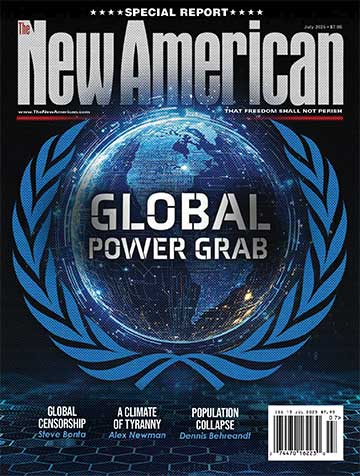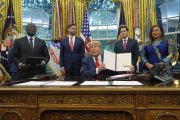
We live in an era in which more and more people, some of them never before involved in politics, are waking up. They do not like what they see.
They see the grip that a relatively small bankster class in control of the Federal Reserve has on the economy; they see the government spending money it does not have — some of it to bail out members of that bankster class and their corporations. They now realize that the country’s current direction, towards an ever larger and more intrusive (and expensive) federal government, combined with a globalist agenda that is outsourcing ever more American jobs, and an increasingly aggressive foreign policy, is unsustainable.
They are reading the U.S. Constitution anew, and wondering where our founding document authorizes the federal government to (for example) force Americans to purchase health insurance (beginning in 2014, in the healthcare “reform” bill just passed by Congress and signed into law by President Obama). The Tea Party movement continues to attract participants — most of them middle-class, many of them admittedly Republicans or former Republicans, all of them very worried about where we are going as a nation.
It is the sort of mood bound to provoke a reaction from those who don’t want their ascent to power questioned or challenged.
Hence the efforts on the part of the media and political elites to tag groups as groups opposing the Obama-Pelosi agenda with labels like fringe or extremist — or even anti-government (implying that anyone who voices opposition to governmental policies is somehow against government).
Above all, with an African-American president in the White House for the first time, leftists would love to tar critics of his policies with brushes like racist and white-supremacist. Such labels, apt to provoke reaction rather than dialogue, would effectively shut down criticism of this administration if made to stick.
There have been a handful of violent actions by individuals who clearly are or were extremists: Scott Roemer, the anti-abortion activist, murders a doctor who performs abortions (Dr. George Tiller). Joe Stack, who had a history of problems with the IRS, flies a private plane into a building housing an IRS office, killing himself and one IRS agent. A lone gunman shoots and kills a security guard outside the Holocaust Museum in Washington, D.C. Members of an isolated group no one had heard of before, the Hutaree, are arrested in Michigan following alleged threats of “war” against the U.S. government. Finally, there are the threats allegedly received by several members of Congress following their passage of the healthcare bill, allegations of vandalism, and allegations that Tea Party members protesting outside of Congress directed racial slurs against African-American members of Congress.
In the hands of left-leaning media, all these incidents form part of a larger pattern. In a recent article, libertarian author and activist Justin Raimondo quotes leftist MSNBC commentator Rachel Maddow as exemplifying this tendency, to use such cases to tar larger groups of people with the extremist and white-supremacist brush:
So, yes, so you can see Roeder as an anti-abortion extremist. You can also identify anti-abortion extremism as one branch of the broader movement of violent, militant, anti-government extremism in this country. We associate that movement with the early and mid-’90s, which is when that tape of Scott Roeder that you just saw was filmed. But just in the last 18 months since President Obama took office, a white supremacist shot and killed a security guard in an attack on the Holocaust Museum in Washington. An anti-tax extremist flew a plane into a building in Texas that housed an IRS office. He killed an IRS worker. Nine suspected militia members [were] arrested for allegedly plotting an attack on police officers as part of a war they wanted to wage against the United States government. A Tennessee white supremacist convicted of plotting to kill President Obama near the end of the presidential campaign in ‘08.
And, of course, there’s Scott Roeder killing Dr. George Tiller.
And, of course, there’s the wave of threats and property damage against members of Congress after the health reform bill passed.
Is it helpful to find the connections between these disparate acts, to understand what American extremism is now? Or are these all individual crazy people with no connection to politics, no connection to each other, no connection to a broader movement or to the broader country at large? What’s the better way to understand this and is this stuff going to stop?
Much of this speaks for itself, in its lumping together of such events as the Tiller murder and a supposed “broader movement of violent, militant, anti-government extremism in this country.” Reread that last paragraph, with its allegation that all these violent events are connected to a “broader movement.” If such an allegation came from a conservative referring to leftist groups, it would probably be dismissed as a “conspiracy theory.”
Patrick J. Buchanan, in a recent column, observes regarding the accusations against the D.C. tea partiers that “neither audio nor video of this alleged incident has been produced, though TV cameras and voice recorders were everywhere on the Hill.” There has been no follow-up by the media. Had the charges been valid, would we be hearing anything else? Buchanan quotes James Clyburn (D-S.C.) accusing Republicans of “aiding and abetting … terrorism” and Frank Rich (New York Times) comparing the Tea Party Movement to Krystallnacht.
For those who remember the history, Krystallnacht (“Crystal Night,” or “Night of Broken Glass”) is the name given the violent pogrom directed by the Nazis during which Jewish Synagogues were torched, Jewish businesses were burned by the hundreds, Jewish men dragged into the streets and beaten up while their wives were sexually assaulted. After Krystallnacht, roughly half of Germany’s Jewish population fled the country.
Isn’t it just a little extreme to compare Tea Party gatherings to such an atrocity? Does this or does this not reflect the growing fear and paranoia on the part of our elites in both the political establishment and the media of a movement they haven’t figured out how to control?
What worries Raimondo, Buchanan, and many other observers is that the demonizing of anyone who opposes big-government policies could offer a sort of prelude to a slow cracking down on freedom of speech, of assembly, and against political dissent generally.
Last year, a leaked 10-page Department of Homeland Security intelligence report sparked strong criticism for associating conservative political opponents of the Obama administration with extremism and terrorism. The DHS document followed on the heels of a report released (and later withdrawn) by the Missouri Information and Analysis Center that similarly associated conservative political opponents with the terrorist threat. That report even cited supporters of former presidential candidates Ron Paul, Chuck Baldwin, and Bob Barr.
The political and media establishments, as I’ve noted, are very worried about the Tea Party Movement and what it implies: a grass-roots public awakening and response to increasingly oligarchic rule.
Call it a “populist” uprising, if you will. Valid criticisms of the movement are possible, many due to the inexperience of those involved. For example, one may reasonably wonder where this movement was when the second George Bush became the biggest spending Republican in U.S. history, and when he signed the unconstitutional USA Patriot Act and the unconstitutional Military Commissions Act. One may believe tea partiers are directing too much attention towards Barack Obama, and that some of their depictions are unwarranted and work against the movement’s best interests (e.g., depicting Obama in Joker make-up).
Of course, it needs to be kept in mind that the Tea Party is a movement, not an organization, and as such it is comprised of who not only have varying levels of understanding but even different beliefs and agendas — from being concerned only about the Democrats’ big-spending policies to a recognition that the problem is bipartisan and that we must expose the political and banking elites’ power grab and get back to the Constitution is we are to save our freedoms.
So far, the Tea Party Movement has not clearly united around the latter theme. Perhaps this is what the elites are afraid may eventually happen, which is why they are so desperate now to brand this movement as fringe and extremist despite its representation of a broad cross-section of middle America.
Photo: AP Images




